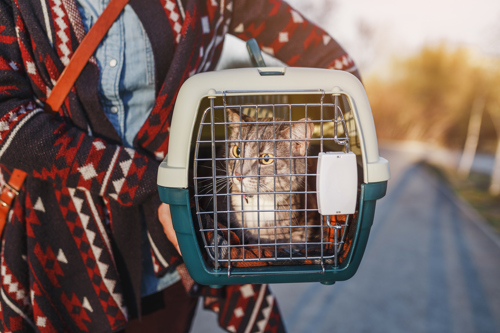Moving to a new home is already a huge hassle, but bringing your pet along can make the process even more complicated. Since pets are prone to reacting strongly to new environments, you’ll need to take extra steps to help them adjust as quickly (and smoothly) as possible. Here, we’ll cover all the basics of how to move with pets with as little stress as possible, whether you’re simply relocating down the street or planting new roots across the country.
1. Preparing to Move
As soon as you lock down your moving date, be sure to schedule an appointment with your vet for a routine health checkup and to get any necessary vaccines and health documents. Traveling with your pet across state lines invokes a handful of state and local rules that vary depending on the type of animal you’re bringing, and you’ll want to build enough time into your schedule to complete all the required checklist items.
To find out the state laws regarding traveling with your pet, visit the USDA Animal and Plant Health Inspection Service and select the state you’re moving to from the drop-down menu. You’ll see detailed fact sheets explaining what you need to do for almost every type of pet, including dogs, cats, horses, birds, rabbits and more. If you have any questions about local regulations, try finding and contacting a vet in your new city ahead of time to ask them any questions.
|
Get everything in order — what to do before you move with your pet:
|
2. Make Sure Your Pet Is Comfortable
On top of using our checklist to prepare for your move, you’ll need to take additional steps to make sure that your pet is as comfortable as possible before the drive or flight itself. If you know your pet gets nervous or has motion sickness, you’ll want to get your vet’s opinion on sedatives or other medications. If you’re unsure as to whether your pet gets sick or anxious in the car, try taking them on drives ahead of time and observing their behavior.
Both cats and dogs share similar symptoms when anxious:
- excessive drooling
- whimpering or crying out in distress
- dogs might pace
- cats will act afraid to move
Again, if your pet has a history of these symptoms during drives, ask your vet about the best course of action.
3. Find the Right Pet Carrier
You'll need a carrier, especially if you plan on driving. It’s important here to note that pets are not allowed in moving vans, and only seeing-eye dogs can accompany the visually impaired on public transportation.
Driving
If you’re driving a personal vehicle, look into a travel pod or small kennel for your small dogs and cats. For medium-size animals, you might want to get a harness that connects to a seatbelt. For larger pets, a crate is best. These items will keep your pets safe, as well as prevent them from being a physical distraction while you’re concentrating on the road. The right carriers will have enough space for your pet to stand in and turn around; a cramped pet is likely to be more anxious and uncomfortable. If you need to stop and stay at a hotel or AirBnB during your trip, make sure that it’s a pet-friendly spot.
Flying
If you’re taking a plane to your new destination, check with your airline to see what the rules are for bringing your pet along in the cabin. (Usually, you can only bring your dog onboard if it’s a service animal, though some airlines may allow carry-on dogs and cats that fit into a small, ventilated carrier.) You’ll want to make sure you have all the necessary items required by your airline and show up at the airport an hour earlier than you usually would to deliver your pet. Note that you cannot travel by air with a puppy or kitten fewer than eight weeks old and prior to weaning.
If you’re moving across the country with pets (or even internationally) and can’t be with them, you may need to find a pet relocation service. Remember, your pet’s like a child — if you use a third-party service to help you transport them to your destination, do your research and shell out a few extra bucks for a first-rate company that will take extra care and precautions with your pet.

4. Keeping Your Pet Calm While You Travel
Once you’re on the road (or in the air), monitor your pet for any anxiousness and keep sedatives, treats, water, toys and other items handy. Maintain a gentle, calm tone of voice when you’re talking to your pet— getting angry or frustrated when they start to whine or get restless will only make matters worse.
If possible, try to keep yourself in view of your pet so they have a calming presence they can see. Placing them in a position where they’re able to look outside the car can also help with anxiety and motion sickness, but never let them roam loose — there’s a real chance that they might get hurt if you were to get distracted or make a sudden stop or turn.
|
Here are some items you’ll want to have with you on your moving trip:
|
5. Moving With Dogs and Cats: Dos and Don’ts
While driving, make frequent stops to allow your pet to stretch and relieve themselves. This is also the best opportunity to hydrate your pets, as water is likely to slosh around your car. For longer trips, especially for dogs, this can also help burn off any excess energy and keep them calmer during the drive itself.
Never let your dog or cat off their leash in a new location (attach the leash before opening your vehicle doors), and avoid leaving your pet in the car on a hot day. Refrain from feeding your pet too large of a meal before the trip, as they may get an upset stomach inside of your car. And as much as they may be enjoying themselves, keep all parts of your pet inside the car at all times — if they stick their head out of the window for too long, they may get irritated eyes and ears from all the dust and grime.
6. Keeping Birds, Fish and Other Pets Calm on the Road
Birds, gerbils and hamsters can be kept in the same cage they stay in at home, though you’ll want to cover up the bird cage with a towel or blanket since they’re more prone to anxiety in new temperatures and settings. Keep all feeding times the same.
With tropical fish, you’ll want to take extra steps to ensure that you’re keeping your pet in a stabilized water temperature, and giving them enough air. Place your fish in minnow buckets with holes or sealed baggies that are only one-third full of water (from the original aquarium) to allow for oxygen, and consider stowing them safely in a Styrofoam cooler to keep the temperature consistent. During your drive, open the baggie every couple of hours to refresh the air supply and add a fish-safe healing liquid to the water to help with any bruising. Since most fish can survive up to a week without food, there’s no need to feed them during travel.
For tips on traveling with more exotic pets, such as rabbits, turtles, monkeys and other animals, check out Pet Travel’s suggestions.

7. Introducing Your Pet to Your New Home
Congratulations — the hard part is over! Once you’ve arrived, you’ll need to support your pet as they get acquainted with their new home. This process doesn’t happen overnight, and it’s best to introduce your pet to their new surroundings slowly to keep their uncertainty and anxiety at bay.
Always use the same bed or crate they slept in at your old home to give them a familiar and calming anchor in their brand-new living environment. By the same token, be consistent with your old routine: feed your pet at the same time, take them for walks and play with them as you did before the move. Set alarms on your phone to make sure you don’t forget to stay on schedule with all the mayhem of unpacking and settling yourself into the new space.
The key is to be patient. It may take time for your pet to become comfortable in your new home. If they're keen on exploring, accompany them and soothe them with a calming voice.
After they’re acclimated to your new space, make sure you update their microchip information (or get a new microchip) and take pictures of your pet so you have recent photos on file in the off chance they try to escape. Find a vet in your area and keep the phone number and address on hand, and start looking into the best parks, trails and other outdoor spots to take them for a walk.









